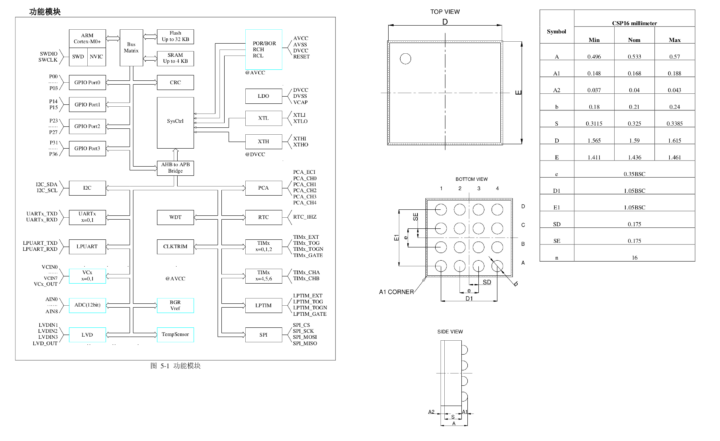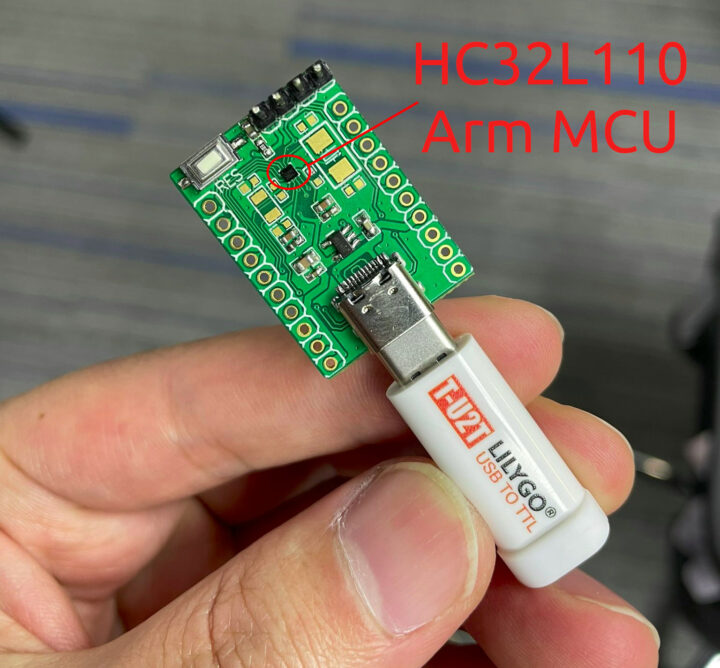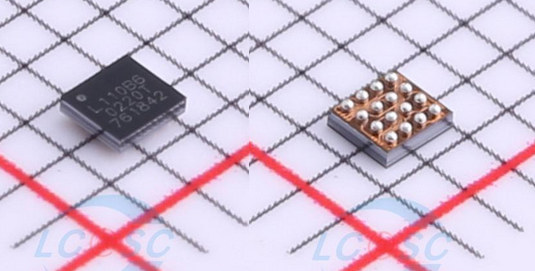Before you ask… No, it’s not another one of those CNXSoft’s typos, I did not mean to write cm (centimeters), and HDSC HC32L110 is indeed an Arm Cortex-M0+ microcontroller available in an almost microscopic 1.59 x 1.436 mm CSP16 package, which could make it the world’s smallest Arm MCU.
I discovered the microcontroller when LilyGO shared a small board only showing the MCU’s dimensions and CSP16 type. Silicon Labs EFM8SB10F8G-CSP16 showed first in a web search, but that’s an 8-bit 8051 microcontroller with a 1.781 x 1.659 mm CSP16 package, and it’s unlikely they’d use a “Western” microcontroller.
But I soon found the microcontroller on Huada Semiconductor Co. Ltd (HDSC) website.
HC32L110 specifications:
- MCU core – Arm Cortex-M0+ 32-bit core @ up to 32 MHz
- Memory – 2KB to 4KB RAM memory with parity check
- Storage – 16K to 32KB flash memory with erase and write protection
- Peripherals
- 16x GPIOs with 20-pin packages, 12x GPIOs with 16-pin packages
- PWM output
- 2x UART, 1x SPI, 1x I2C
- Up to 9-channel 12-bit SARADC with up to 1Msps sampling
- Buzzer frequency generator
- Timer/Counter
- 3x general-purpose 16-bit timers/counters
- 3x high-performance 16-bit timer/counter
- 1x low power 16-bit timer/counter
- 1x programmable 16-bit timer/counter with comparison support
- RTC
- 2-way voltage comparator VC with integrated 6-bit DAC and programmable reference input
- Clock, crystal oscillators
- External high-speed crystal oscillator 4 ~ 32MHz
- External low-speed crystal oscillator 32.768KHz
- Internal high-speed clock 4/8/16/22.12/24MHz
- Internal low-speed clock 32.8/38.4KHz
- Watchdog timer
- Hardware supports internal and external clock calibration and monitoring
- Security – CRC-16 module, unique 10-byte ID number
- Debugging – Embedded debugging solution providing a full-featured real-time debugger
- Power Management
- Operating voltage – 1.8 to 5.5V
- Integrated low voltage detector LVD, configurable 16-level comparison level
- Power consumption
- 0.5μA @ 3V in deep sleep mode (all clocks off, power-on reset valid, IO status maintained, IO interrupt valid)
- 1.0μA @ 3V in deep sleep mode + RTC operation
- 6μA in 32.768KHz low-speed active mode (CPU and peripheral modules run, run programs from flash)
- 20μA/MHz @ 3V @ 16MHz in sleep mode (CPU stops working, peripheral modules run, main clock runs)
- 120μA/MHz @ 3V @ 16MHz while active (CPU and peripheral modules run, run programs from flash)
- Wake-up time – 4μS ultra-low-power wake-up time
- Temperature range – -40 ~ 85C
- Packages
- QFN20 – 3 x 3 mm
- TSSOP20 – 6.5 x 4.4 mm
- TSSOP16 – 5 x 4.4 mm
- CSP16 – 1.59 x 1.436 mm

The microcontroller seems to have been released in 2020, and there’s plenty of documentation on the product page. You’ll also find the software development tools, and IAR Embedded and Arm Keil MDK are the recommended/supported IDEs for the microcontroller. Everything is in Chinese, but this may change soon if LilyGO releases the board for the “overseas market”.
HC32L110B6YA-CSP16TR is sold on LCSC China, but I could not find it on the international version of the website at the time of writing. The sample price is 5.67 CNY (89 cents US), and the unit price drops to 3.14 CNY (50 cents US) in quantities of 1,000 pieces or more.

Jean-Luc started CNX Software in 2010 as a part-time endeavor, before quitting his job as a software engineering manager, and starting to write daily news, and reviews full time later in 2011.
Support CNX Software! Donate via cryptocurrencies, become a Patron on Patreon, or purchase goods on Amazon or Aliexpress. We also use affiliate links in articles to earn commissions if you make a purchase after clicking on those links.






It is tiny and great in specs for its price and size, what’s not to like?
It could be a great standby-mode controller, and if not for omission of better security features, it could be a security module for some.
The usual problem with these is that you need microvias to access the inner balls on the grid.
There are also TSSOP16/20 and QFN20 variants.
Very small 😅 Can we program it as a arduino ?
I personally have not met an ARM that cannot work like an Arduino
I have one with 96 cores and 128GB of RAM .. how do I turn it into 96 arduinos?
Still too big to be the PRC spy chip that Bloomberg reported about a few years ago…
The MAX32660 is a Arm Cortex-M4 in a 1.6mm x 1.6mm with faster clock, more RAM and more FLASH: 96MHz, 96KB SRAM, 256KB Flash
https://www.maximintegrated.com/en/products/microcontrollers/MAX32660.html
In large volume it’s $2.16
There’s also a dev kit for $20: https://www.maximintegrated.com/en/products/microcontrollers/MAX32660-EVSYS.html
Why aren’t those Darwin chips popular?
Thanks for that info.
I’m just realizing that these tiny chips could easily be installed on DIL-sized PCBs and emulate or improve various discrete chips (555, 74LS, 40xx, various PALs/GALs, encoders/decoders etc) to patch existing products.
Wouldn’t the little lattice FPGAs work for that too?
Oh yes, and even better; it just happens that there are more people able to program ARM CPUs than FPGAs. We’ve seen some people using PIC12C508 to replace 555s or setup-up regulators in the past, we’re just seeing that practice of bringing discrete chips to the masses being still possible.
When you consider what complex machine code programs, a 8 bit Ziglog Z80 at 3.5MHz ran. There is a lot these chips could do.
What do you even mean? The reason you can emulate chips for stuff like the speccy and C64 in software on a microcontroller is because the microcontroller is so much faster than those 6502 or z80 based systems could ever be.
The dimensions of DA14531 (2.0 x 1.7 mm) are not much worse, while the chip is also BLE 5.1